William Strode (1562–1637)
Sir William Strode (1562–1637) of Newnham in the parish of Plympton St Mary, Devon, England, was a member of the Devon landed gentry, a military engineer and seven times a Member of Parliament elected for Devon in 1597 and 1624, for Plympton Erle in 1601, 1604, 1621 and 1625, and for Plymouth in 1614. He was High Sheriff of Devon from 1593 to 1594 and was knighted in 1598. In 1599 he was appointed Deputy Lieutenant of Devon. There is a monument to him in the parish church of Plympton St Mary.
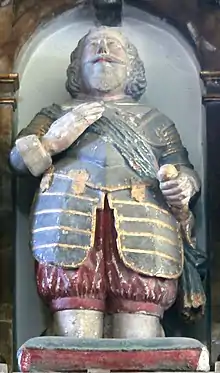
Biography

Strode was the only son of Richard Strode (died 1581) of Newnham, Plympton St Mary, by his wife Frances Cromwell, first cousin of King Edward VI (1537–1553). Frances was a daughter of Gregory Cromwell, 1st Baron Cromwell (c. 1520 – 1551) (only son of Thomas Cromwell, 1st Earl of Essex (c. 1485 – 1540), chief minister of King Henry VIII) by his wife Elizabeth Seymour, sister of Queen Jane Seymour and sister of Edward Seymour, 1st Duke of Somerset[1] (c. 1500 – 1552) uncle and Lord Protector of King Edward VI.
He entered Inner Temple in 1580 and succeeded to the estates of his father the following year. At the time of the Spanish Armada (1588) he became a colonel of the stannary of Plympton, in command of one hundred men. He was a JP for Devon from about 1592. In 1593 he came into possession of the family tin-mining interests which were previously managed by his uncle, Philip Strode and was appointed High Sheriff of Devon for 1593–94. In 1595 he was in charge of construction works on Plymouth fort. He was a close friend of Admiral Sir Francis Drake (died 1596) and was one of the executors of Drake's will.[2]
In 1597, Strode was elected Member of Parliament for Devon. He was appointed surveyor of the house and castle of Templeton, Devon for life. In 1599 he became Deputy Lieutenant. He was elected MP for Plympton Erle in 1601 and was re-elected for the seat in 1604. In 1606 he was appointed surveyor of Devon for life.[2] He was re-elected MP for Plympton Erle in 1614 and in 1621. In 1624, he was elected MP for Devon. He was elected MP for Plympton Erle again in 1625 and 1626.[3]
As well as Newnham, Strode also had a residence at Meavy,[4] about six miles to the north, which was later the residence of his second son William Strode (1594–1645), MP.[5] His great-grandfather Richard Strode (died 1552) had married Agnes Milliton, daughter of John Milliton of Meavy.[6]
Strode died in 1637 and was buried in the church of St Mary's Plympton, where there is a monument to him (see photograph below). His will was proved in February 1639.[2]
Marriages and children

Strode married twice.[5] Firstly in 1581 to Mary Southcote (died 1618) daughter of Thomas Southcote (died 1600), MP, of Bovey Tracey, by whom he had three sons and seven daughters:[5]
- Sir Richard Strode (1584–1669), MP, eldest son and heir.
- William Strode (1594–1645), MP, second son, one of the Five Members whose attempted arrest in the House of Commons of England by King Charles I in 1642 sparked the Civil War.
- John Strode, third son, of Tavistock, who died at some time after 1644.
- Mary Strode (born 1586), eldest daughter, married Sir George Chudleigh, 1st Baronet (1582–1656), of Atherington. She predeceased her husband and was buried in Ashton Church.[7]
- Joanna Strode, second daughter, married in 1615 as his second wife, Sir Francis Drake, 1st Baronet (1588 – c. 1637), of Buckland, nephew of his namesake the great Admiral.[8] She remarried in 1639 at Bere Ferrers (or Buckland Monachorum) to John Trefusis of Milor (or of Trefusis), Cornwall.
- Ursula Strode (died 1635), his third daughter, married Sir John III Chichester (1598–1669), MP, of Hall, Bishop's Tawton. Her mural monument exists in Bishops Tawton Church (see photograph below).
- Frances Strode, fourth daughter, married in 1606/7 to Sir Samuel Somaster, Knight (born 1692), of Painsford, Ashprington.
- Juliana Strode (died 1627), his fifth daughter married Sir John Davie, 1st Baronet (died 1654), of Creedy, Sandford, near Crediton, Devon. A mural monument to her survives in Sandford Church (see photograph below).
- Margaret Strode, sixth daughter, married Sir John Younge of Stetscome.
- Elizabeth Strode, seventh daughter, married Edmond Speccot (died 1620) of Anderdon, Cornwall, second son of Humphrey Speccot, MP, of Speccot, in the parish of Merton, Devon.[9]
Strode's second marriage, in 1624 was to Dunes Glanville (died 1635) daughter of Nicholas Glanville, who was brother to Sir Sir John Glanville (1542–1600).[10] He was her third husband; they had no children.[11]
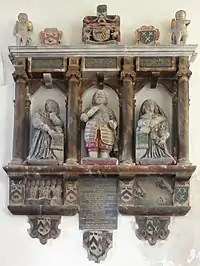 Sir William Strode's mural monument in St Mary's Church, Plympton
Sir William Strode's mural monument in St Mary's Church, Plympton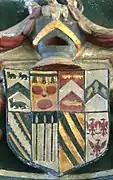 Detail of shield atop Strode's monument showing heraldic quarterings
Detail of shield atop Strode's monument showing heraldic quarterings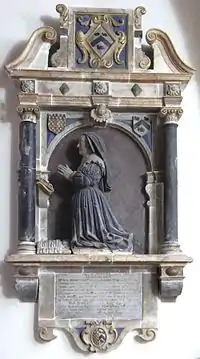 Mural monument to Ursula Strode (d. 1635), Bishop's Tawton Church
Mural monument to Ursula Strode (d. 1635), Bishop's Tawton Church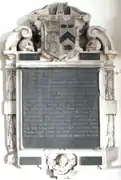 Mural monument to Juliana Strode (d.1627), Sandford Church
Mural monument to Juliana Strode (d.1627), Sandford Church
References
- Risdon, p. 198
- History of Parliament Online - William Strode
- Browne Willis Notitia parliamentaria, or, An history of the counties, cities, and boroughs in England and Wales: ... The whole extracted from mss. and printed evidences 1750 pp156-218
- Risdon, ("Meavy Church") p. 195; Pole, ("Mewy") p. 337
- Vivian, p. 719
- Vivian, p. 718
- Vivian, p. 190, pedigree of Chudleigh of Ashton
- Vivian, p. 299, pedigree of Drake
- Vivian, pp. 706–7, pedigree of Speccot of Thornbury
- Per inscription on Strode's monument and per Vivian, p. 411
- Per inscription on Strode's monument
Sources
- Hasler, P. W., biography of Sir William Strode published in History of Parliament: House of Commons 1558-1603, ed. P.W. Hasler, 1981
- Risdon, Tristram (died 1640), Survey of Devon. With considerable additions. London, 1811.
- Vivian, John Lambrick (1895). The Visitations of the County of Devon: Comprising the Heralds' Visitations of 1531, 1564 & 1620. Exeter: Henry S. Eland. – pp. 718–720, pedigree of Strode